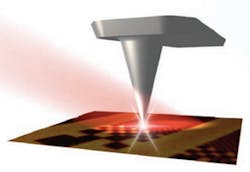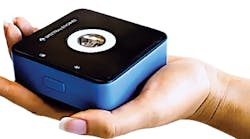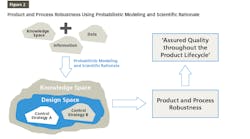Process Analytical Technology (PAT) and instrument vendors are continually advancing the usability, reliability, accuracy and efficacy of their technologies, and the first half of 2015 is no different. Companies in this sector introduced technological advancements and other innovations to better support lab and QA/QC operations.
When it comes to demonstrating new analytical equipment to the industry, PittCon has traditionally been a primary launching point for introducing PAT systems and innovations to the industry. Several vendors brought out new systems or introduced significant new features at the conference.
SPECTROSCOPY
Figure 1. Scatter-spectrum effect of Spectroclick instrument.
Spectroclick shared an interesting, compact spectrometer. While it is "merely" a visible spectrometer, its methodology is unique. It is a portable instrument making use of consumer-grade megapixel camera technology to generate absorption spectra from 430 nm to 720 nm with intensity dynamic range comparable to instruments with more expensive detectors. Using stacked gratings technology to produce SpectroBurst data (see Figure 1), they trade intensity dynamic range and wavelength resolution without moving parts- and graphic display is unusual enough to be noted. Associated software leads users through the steps of a determination so that no advanced training is required.A small, rugged system for transmission imaging was developed by InnoSpec GmbH. Working in two ranges (950-1700nm or 1200-2200nm) with a 320 x 256 pixel InGaAs (thermoelectrically cooled) detector, the instrument can achieve a spatial resolution of < 35?m. The image size is 7.68 mm (spectral) by 9.6 mm (spatial); the instrument (400 x 184 x 180 mm) weighs 7 kg, and runs on a 24V battery.
SOFTWARE TOOLS
Although the focus so far has been hardware, vendors are offering some nice additions to the software "toolbox" and are worth mentioning. For the third time in five years, RuRo brought the innovation to PittCon. While there are a number of LIMS systems on the floor, RuRo's Limfinity system uses an interesting approach. Instead of offering a number of software packages for each application (each needing to be shown 21CFR11 compliant), their approach is a single platform that can be configured for each application (billing forms, test samples, patients' information, sequencing instrumentation, or any other item to be managed/controlled).
MISCELLANEOUS
A number of vendors have introduced non-spectroscopic tools worth highlighting. As far as a delightfully simple idea is concerned, Hanna Instruments showed a stand-alone (WiFi/Bluetooth-based) pH electrode, named edgeblu. The WiFi range is 10 meters and they can be monitored by the base supplied or a wireless device (smartpad) with the proper app installed. Envision a number of these placed into fermentation or API synthesis tanks and monitored by either a roaming station or a centrally located monitor (which then can relay data to an office), and imagine the operational benefits the data points and related transparency will bring and you might understand how effective deploying this tech might be for your organization.
Excellims has added a high-performance ion mobility (HPIMS) spectrometer to its inventory, the IA3100 HPLC-HPIMS system. When coupled with an HPLC, the HPIMS acts as a mass spectrometric detector. A small fraction of the eluate from the LC is directed to the IMS, ionized with an electrospray ionizer, and sent through the IMS chamber. The mass/shape sensitivity of the IMS can "see" differences not apparent in a LC column.
For example, any isomers that co-elute from an LC column (e.g., Leucine and Isoleucine or Melezitose and Raffinose) can easily be separated. UV transparent compounds (e.g., Fructose and Glucose, both with a MW of 180) are also well separated on the instrument. And, as with any IMS instrument, no vacuum pump is used; a low velocity of ambient air is directed against the ions to effect separation. The effect of LC and IMS data is to easily produce two-dimensional information/schemes.
Sirius showed their new Insight Particle Size and Shape Analyzer. The Sirius Insight is a particle size analyzer that utilizes two measurement methods: Laser Obscuration Time (LOT) and digital video imaging. This approach enables the measurement of particle size using the LOT technique and provides a large number of particle shape parameters through dynamic image analysis.
LOT is independent of optical properties and makes no assumptions about the particles being measured (e.g. shape or refractive index). This makes it suitable for making size measurements on samples which are either single compounds or mixtures of compounds. Not being a volume-based measurement, it can be used for poly-dispersed samples or minor size fractions. LOT is a time-domain measurement, making it suitable for solids concentration measurements. Its dual-channel detection does two things: the video channel enables determination of various particle shape parameters, enabling material behavior to be correlated with particle properties other than size.
Oselsa Inc. makes an interesting tool: a Random Pattern Projector (RPP). The RPP is a divergent dot matrix pattern of NxM pixels with a ratio of bright and dark pixels of about 15% (each bright pixel is surrounded by a minimum of 8 dark ones, with none of the bright pixels touching). The distribution is pseudo-random, yet symmetric with respect to the center. Recommended uses are 3d stereo vision, gesture recognition, volume measurement, bin picking, depth sensing and palletizing. I suggested that it would also produce a working pattern for arranging fibers in a bundle to assure over-all light distribution for (spectroscopic) sampling.
Skyray Instrument Co. was showing two hand-held x-ray fluorescence (XRF) instruments. Low cost and easily used, while designed for metallurgical work, there are occasions where "spots or particles" are found in products and a rapid analysis of them is required. It may be used to detect/measure elements from Sulfur to Uranium (76 Element Total) with a precision of 0.05% - .1% STD. It only weighs 1.35Kg and can be used with line current or batteries.





